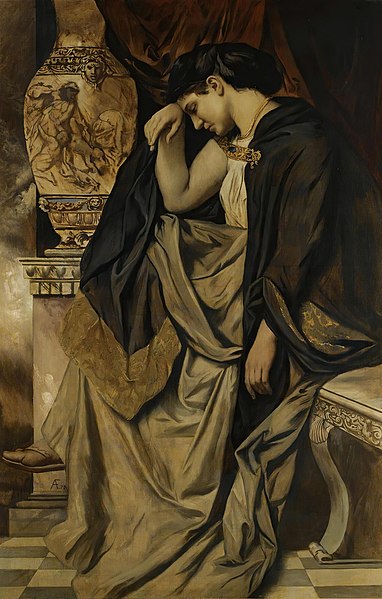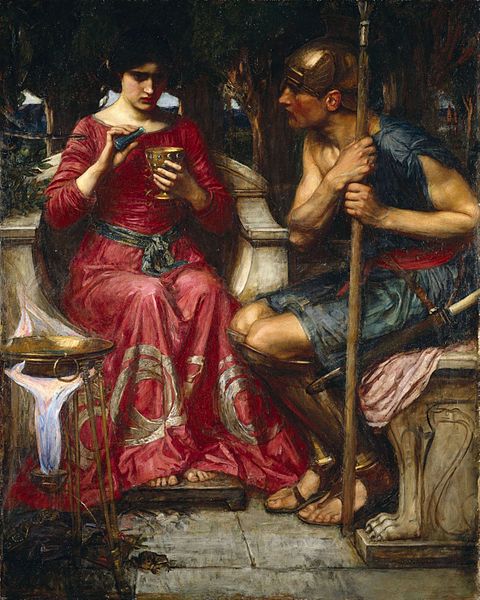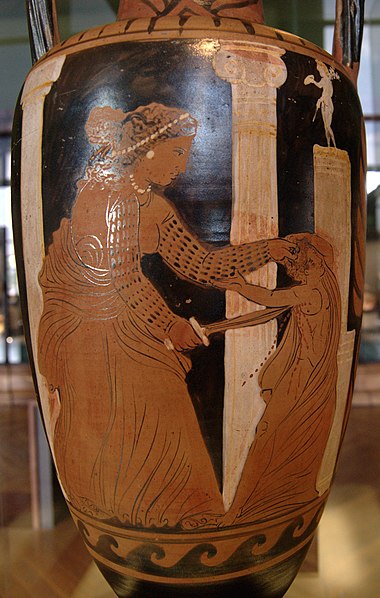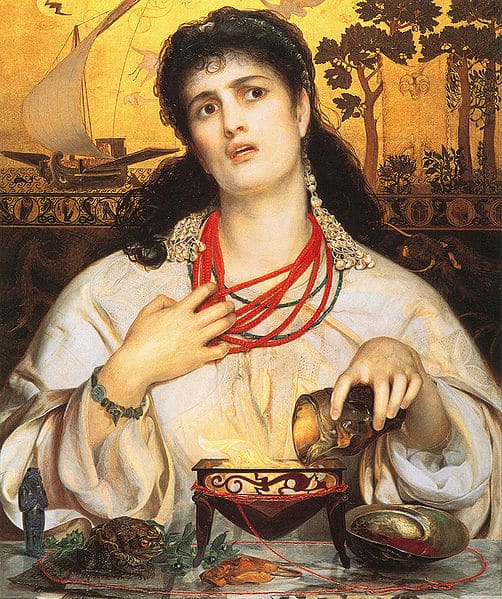The world of Greek mythology is replete with figures who captivate, inspire, and sometimes terrify. Among them stands Medea, a sorceress whose story intertwines with love, betrayal, and magic. Her narrative, filled with passion and vengeance, has been retold across generations, making her one of the most intriguing figures in ancient lore.
Medea’s tale is not just about her magical abilities but also about the complexities of her emotions and decisions. As we delve into her story, we discover a woman who, despite her divine powers, grappled with very human dilemmas.
Medea Key Facts
Family tree
| Parents | Aeëtes (father) and Idyia (mother) |
| Partner(s) | Jason |
| Siblings | Absyrtus (brother) |
| Offspring | Mermeros and Pheres (with Jason) |
Names & Others
| Roman Name | Medea |
| Other Names | None |
| The Goddess of | Magic and Witchcraft |
| Symbols | Chariot drawn by dragons, herbs, and potions |
Name and Etymology
Medea, a name that resonates with magic and mystery, has its roots in ancient Greece. The name itself doesn’t have a clear etymology, but it’s believed to be derived from the Greek word “μήδομαι (mēdomai)” which means “to ponder or devise.” This could allude to her cunning nature and her skills in devising intricate spells and potions.

In Roman mythology, Medea retains her Greek name, a testament to her iconic status and the universality of her story. Throughout various tales and retellings, she doesn’t adopt many epithets, but she’s often referred to in context with her sorcery and her relationship with Jason.
Her name has become synonymous with betrayal and vengeance in popular culture, but a deeper dive into her story reveals layers of complexity that go beyond the stereotypes.
Medea’s Family and Childhood
Born to King Aeëtes of Colchis and Queen Idyia, Medea was of divine descent. Her grandfather was none other than the sun god, Helios, and her aunt was the enchantress Circe. With such a lineage, it’s no surprise that Medea herself was gifted with formidable magical abilities.
Her childhood in Colchis, a land at the edge of the Greek world, was steeped in magic and mystery. Colchis was known for its wealth, its sacred groves, and its connection to the divine. Growing up, Medea was trained in the arts of sorcery, and she quickly became a formidable sorceress, often compared to her famed aunt, Circe.
While many tales focus on her later life, her early years in Colchis shaped her. It was here that she first encountered Jason, setting the stage for a saga of love, betrayal, and magic.
Medea’s Lovers and Relationships
Medea’s life was profoundly influenced by her relationship with Jason, the leader of the Argonauts. Their love story, while passionate, was also marked by treachery and tragedy.

When Jason arrived in Colchis in search of the Golden Fleece, Medea was immediately smitten by him, a sentiment often attributed to Eros, the Greek God of love intervention. She played an instrumental role in helping Jason obtain the Fleece, betraying her own family in the process.
Their adventures together, filled with trials and tribulations, showcased Medea’s unwavering loyalty and her formidable magical abilities. However, their relationship was not destined for a happy ending. Jason’s eventual betrayal, where he chose to marry another for political gain, led Medea down a path of vengeance, culminating in events that would forever mark her as one of Greek mythology’s most tragic figures.
Medea’s children
Medea and Jason’s union bore children, but their fates were intertwined with the tragic trajectory of their parents’ relationship.
Mermeros and Pheres
The children of Medea and Jason, Mermeros and Pheres, were caught in the crossfire of their parents’ tumultuous relationship. In some versions of the myth, in a fit of rage and despair over Jason’s betrayal, Medea took the lives of their children, viewing it as the ultimate act of vengeance against Jason. This act, more than any other, solidified Medea’s reputation in mythology as a woman driven to extreme measures by passion and betrayal. The tragic fate of her children serves as a somber reflection on the devastating consequences of love gone awry.
Depiction And Characteristics
Medea, with her intricate blend of strength and vulnerability, has been a subject of fascination for artists and writers alike.
She is often depicted as a beautiful woman, with an aura of both allure and danger. Her attire typically reflects her status as a sorceress, often adorned with symbols of magic and mystery. In many artworks, she’s seen with potions, indicative of her expertise in herbal magic and poison. Her chariot, drawn by dragons, is another recurring motif, symbolizing her divine lineage and her mastery over beasts.
Medea’s Personality and Powers
Beyond her magical abilities, Medea’s personality is a complex tapestry of love, loyalty, cunning, and vengeance. She’s a woman of profound emotions, capable of deep love and loyalty, as seen in her early relationship with Jason. However, betrayal turns her love into wrath, leading her to commit acts that have made her a controversial figure in mythology. Her intelligence and cunning are evident in how she navigates challenges, often using her wits and magic to outsmart her adversaries.
As a sorceress, Medea’s powers were vast. She was skilled in herbal magic, potions, and poisons. Her knowledge of herbs allowed her to create love potions, healing elixirs, and deadly toxins. She could also summon and control beasts, a skill she inherited from her divine lineage. Her ability to rejuvenate the old into youth, as seen when she rejuvenated Jason’s father Aeson, showcases the depth of her magical prowess.
Medea’s Symbols, Animals, or Plants
Medea’s association with magic and sorcery is often symbolized through various elements in mythology.

Herbs and Potions
Given her expertise in herbal magic, herbs, and potions are synonymous with Medea. She’s known to have a profound knowledge of the properties of plants, using them for various purposes, from healing to harm.
Medea’s chariot, drawn by dragons, is a testament to her divine heritage and her mastery over magical creatures. The dragons, often seen as guardians of treasures and secrets, reflect Medea’s own role as a keeper of arcane knowledge.
Medea’s Roles And Responsibilities
In Greek mythology, Medea’s role transcends that of just a sorceress or a jilted lover. She embodies themes of love, betrayal, revenge, and the complexities of human emotions.
Medea’s primary responsibility in myths revolves around her expertise in magic. Whether it’s aiding Jason in his quest for the Golden Fleece or seeking revenge against those who wronged her, her magical abilities are central to her narrative. However, her role isn’t limited to just her magical feats. Medea also serves as a reflection on the consequences of blind love and the lengths one might go to when betrayed.
Furthermore, Medea’s journey from Colchis to Corinth and then to Athens showcases her adaptability and resilience. In each phase of her life, she takes on different roles. First as a helper, then a lover, and a mother, lastly a vengeful sorceress. Her multifaceted character serves as a reminder of the complexities of human nature and the duality of love and hate.
Myths about Medea
Medea’s life, as chronicled in Greek myths, is a roller-coaster of love, betrayal, magic, and revenge.
Medea and the Golden Fleece
Medea’s introduction in Greek mythology is intrinsically linked to the quest for the Golden Fleece. When Jason and the Argonauts arrive in Colchis, it’s Medea’s love and magical assistance that enable Jason to overcome the challenges set by her father, King Aeëtes, and retrieve the Fleece. However, this act of love and betrayal sets the stage for the subsequent tragedies in her life.
Medea’s Revenge on Pelias
After assisting Jason in obtaining the Golden Fleece, Medea plays a pivotal role in enacting revenge on King Pelias, who had usurped the throne from Jason’s father. Using her cunning and magical abilities, Medea tricks Pelias’s daughters into killing their father, believing that she would then rejuvenate him. This act further cements Medea’s reputation as a formidable sorceress, capable of both creation and destruction.
Medea’s Tragedy in Corinth

After obtaining the Golden Fleece and exacting revenge on Pelias, Jason and Medea settled in Corinth. There they lived for a decade and had two children. However, their seemingly peaceful life took a dark turn. Seeking political power and influence, Jason decided to marry Glauce, the daughter of Creon, the King of Corinth. Feeling betrayed and abandoned, Medea’s love for Jason turned to intense hatred.
In a fit of rage and vengeance, she crafted a poisoned robe and gifted it to Glauce. The robe later led to the princess’s death upon wearing it. But Medea’s revenge didn’t stop there. To inflict the deepest pain upon Jason and ensure he had no legacy left, she made the heart-wrenching decision to kill their two children, Mermeros and Pheres. After these tragic events, Medea fled Corinth on a chariot provided by her grandfather, the sun god Helios, leaving a devastated Jason behind.
Medea and Aegeus
After the tragic events in Corinth, Medea finds refuge with King Aegeus of Athens. Unaware of her past, Aegeus welcomes her, and they form a bond. However, as Medea’s past catches up with her and her actions come to light, even this sanctuary is lost to her.
“Of all creatures that can feel and think, we women are the worst treated things alive.” – Medea, as quoted in Euripides’ “Medea.”
Medea In Ancient Greek Religion

Medea is a prominent figure in Greek mythology. However, her role in ancient Greek religion is not as pronounced as some other deities or heroes.
Her association with places like Colchis and Corinth have left an indelible mark on these regions’ cultural and mythological landscape.
Primarily being a figure of myth rather than a deity of worship, she didn’t have festivals dedicated to her. However, her story was often recounted in plays and performances. Most notably in Euripides’ tragedy “Medea,” which delves deep into her psyche and the events that shaped her life.
Representations Of Medea In Art
Medea’s compelling story has inspired countless artists over the centuries. From ancient pottery depicting her deeds to Renaissance paintings showcasing her beauty and anguish, Medea’s portrayal in art is as varied as her character.
One of the most iconic representations is “Medea” by Frederick Sandys. In the painting she’s depicted with wild, flowing hair, holding a potion, symbolizing her role as a sorceress. Another notable artwork is “Jason and Medea” by John William Waterhouse. That painting is capturing the moment of their first meeting, with Medea looking on Jason, looking both curious and enchanted.
Mentions in Ancient Texts
Medea’s story is chronicled in various ancient texts, with each offering a unique perspective on her character and deeds.
Euripides’ tragedy “Medea” is perhaps the most comprehensive account of her life post her time with the Argonauts. The play delves deep into her Psyche, The Deification Of The Human Soul, exploring the complexities of her emotions and the reasons behind her drastic actions. In the play, Medea’s dialogue offers profound insights into her character, as she grapples with feelings of love, betrayal, and vengeance.
Another notable mention is in Apollonius of Rhodes’ “Argonautica,” which chronicles the journey of the Argonauts. It also provides a detailed account of Medea’s role in their quest for the Golden Fleece.
“Love, unconquerable Wrecker of rich men, keeper of warm beds of fresh-plowed furrows, we in our bitterness call you to account for children born and battles fought.” – Medea, as quoted in Apollonius of Rhodes’ “Argonautica.”
Frequently Asked Questions
Medea was the daughter of King Aeëtes of Colchis and Queen Idyia.
Medea fell deeply in love with Jason, possibly due to Eros’s intervention. She aided him in his quest for the Golden Fleece, however she betrayed her own family in the process.
Yes, they had children, most notably Mermeros and Pheres. Their fate is intertwined with the tragic trajectory of their parents’ relationship.
Medea is best known for her relationship with Jason, and the tragic events that followed later.
No, Medea was not a goddess but a sorceress of great power. She was, however, of divine descent, with her grandfather being the sun god, Helios.
After the tragic events in Corinth, Medea sought refuge in Athens with King Aegeus.
Featured Image Credit: Typhon2222, Public domain, via Wikimedia Commons
